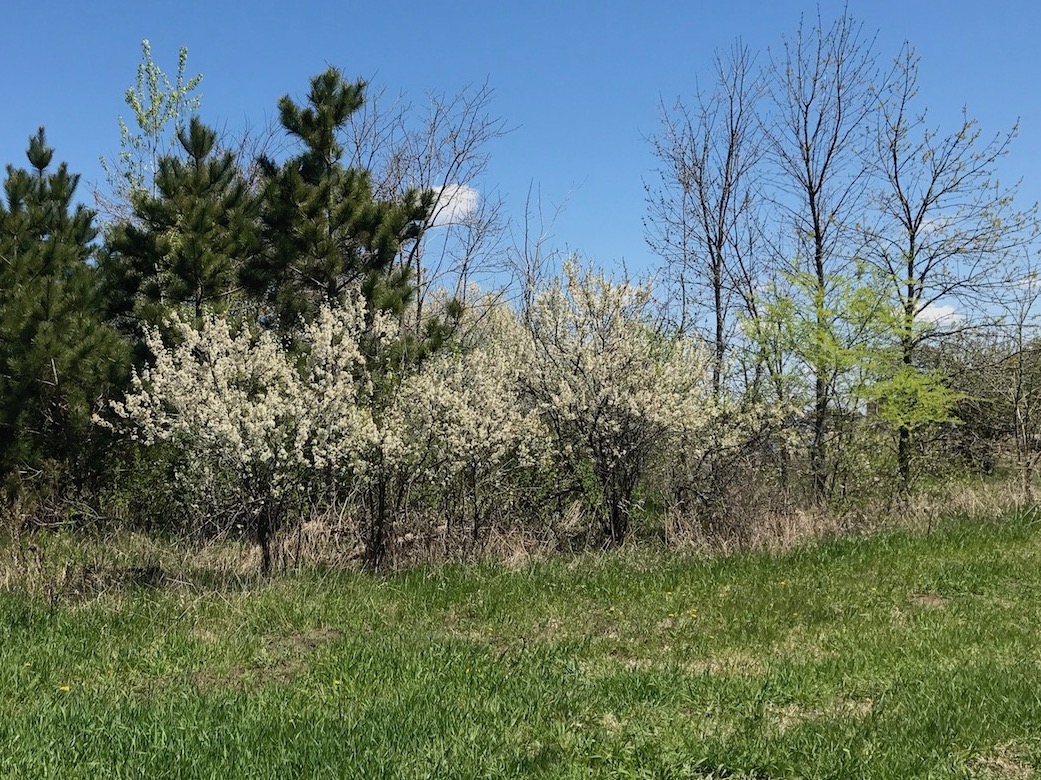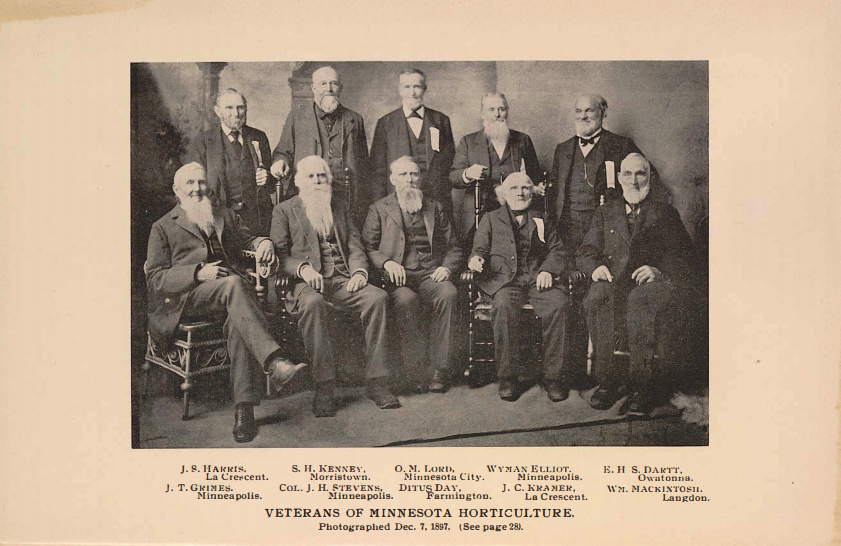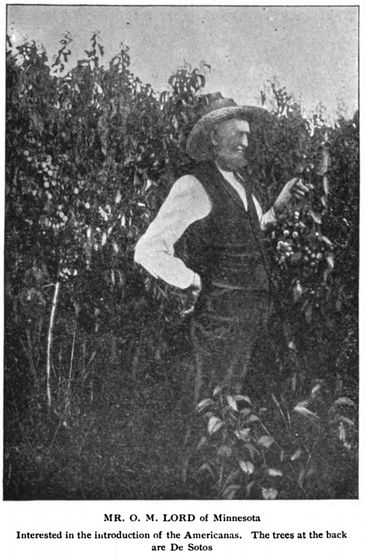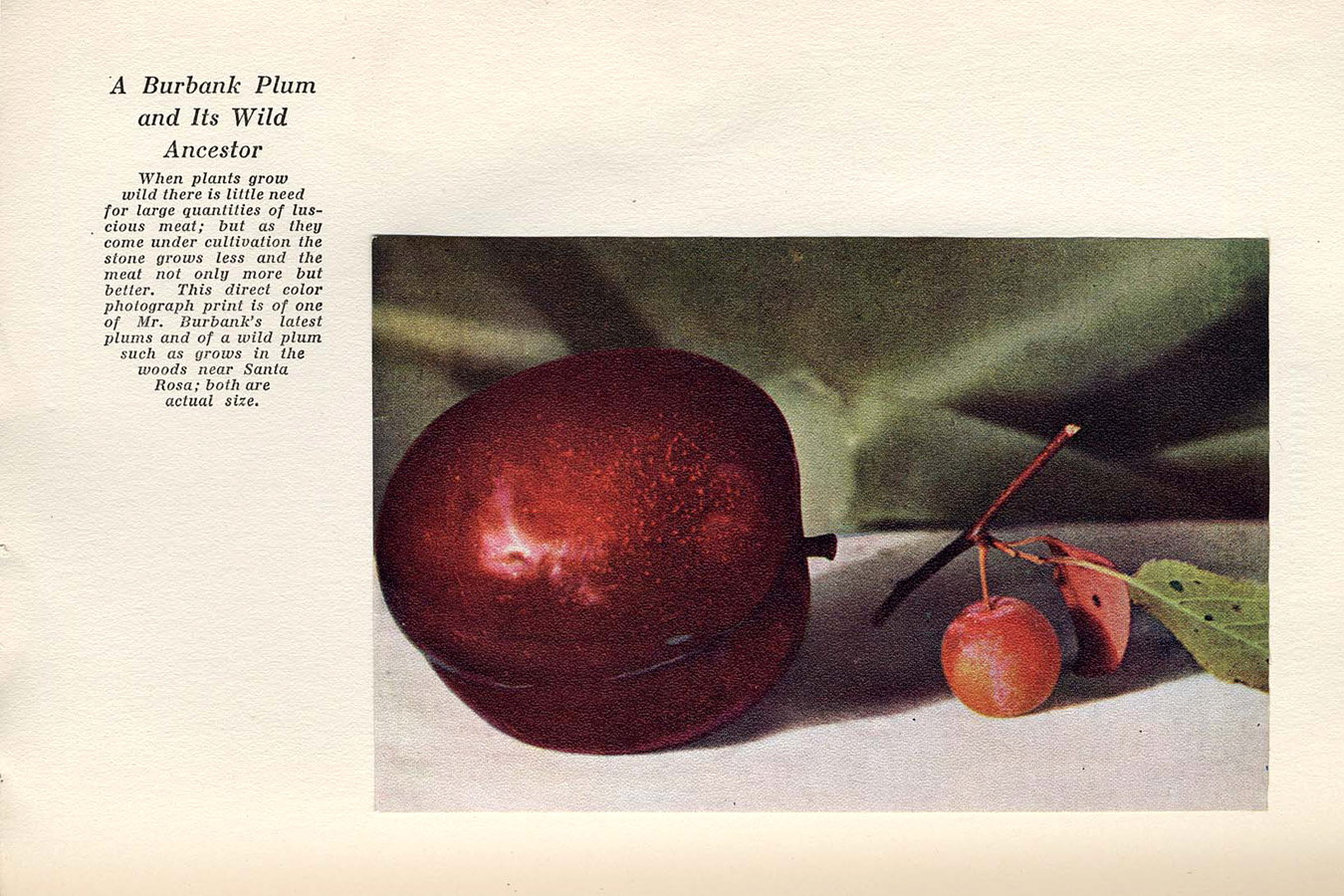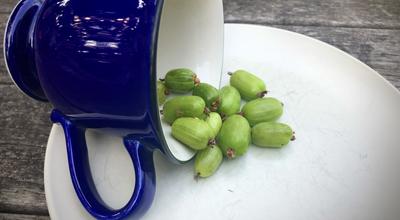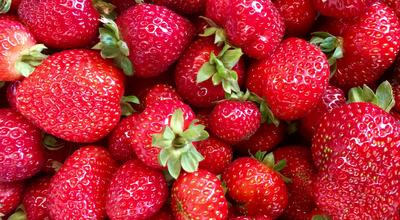
The quest for cold hardy fruits
There are some areas of the United States that are renowned for growing fruit trees. Georgia is famous for its peaches. Washington and New York pride themselves on being top apple producers. In California, just about every fruit tree is right at home. Even Michigan is known for its cherries. And then there’s Minnesota, a state in the Upper Midwest on the border of Canada. The famously frigid winters make Minnesota about the last place one would expect to find fruit trees, which is the reality settlers faced when they began arriving in the mid 1800s. The determination of a handful of fruit growers who vowed to change this fate helped establish the University of Minnesota fruit breeding program in 1878. Since then, the program has developed over 100 hardy fruit varieties, including apples, grapes, plums, cherries, apricots, pears, and berries. In this state where early settlers lamented the lack of fresh fruit, commercial orchards are now abundant, and home gardens are dotted with lovingly tended fruit trees.
In recent years, the University of Minnesota fruit breeding program has focused on apples and grapes, yet the program’s early work on plums effectively changed the food landscape for people in northern regions. For almost 140 years, these plum varieties have played an important role in the story of cold climate fruit production: from early settlers seeking food to survive, to today’s consumers seeking a return to locally produced food.
A picture of Minnesota’s climate
Minnesota’s continental climate means cold winters, hot summers, and variable precipitation. During the winter, it is common to see as many as 50 days below -17 °C accompanied by harsh, drying winds that accelerate across the open plains. The state averages 140 cm of annual snowfall, however snow cover varies dramatically from year to year. Historically, it has snowed in every month of the year except July. Spring consists of drastic temperature fluctuations and inconsistent moisture. Frost is common across the state well into May, and in some areas until mid-July. This equates to an unpredictable start to a short growing season which averages 90 to 160 days. The hot summers commonly bring temperatures above 35 °C accompanied by damaging storms with high winds and hail. On average, over half of the annual precipitation occurs between May and September (MN DNR 2017).
Each season presents its own challenges for farmers and gardeners, but it is primarily the severe cold that limits the success of perennial plants like fruit trees. When settlers encountered their first few Minnesota winters, they wondered about the practicality of choosing this harsh landscape for their homes.
Driven to grow fruit trees
Around 1850, settlers from the eastern United States and Europe began arriving in Minnesota with hopes of striking gold through agriculture. Even more made the trek with the passing of the Federal Homestead Act in 1862, which gave 160 acres of land to any adult citizen, under the condition that the land be improved with dwellings and crops. Between 1862 and 1880, over 62,000 homesteads were established on 7.3 million acres in Minnesota. Settlers were drawn to the state by the rich prairie land that promised ample harvests of wheat, oats, and corn (Granger and Kelly 2005). The land was flat, the soil fertile, and the water plentiful. These crops grew vigorously, and rewarded farmers for their willingness to endure the harsh environment of the northern plains. Ample wheat harvests did not, however, mean that life was easy. Food was extremely limited, and fresh fruits and vegetables were scarce. Settlers were encouraged to establish gardens and orchards, thus many planted seedlings of their favorite fruit varieties from back east only to be disappointed when, after a few typical Minnesota winters, the trees died. Threat of malnutrition and scurvy was accompanied by heartfelt disappointment:
A majority of our citizens have lived in the Eastern States, and been accustomed to an unstinted supply of apples, peaches, pears, plums, cherries, etc. To be deprived of them and to have no hope of ever seeing or using them more, takes all the poetry out of their lives. (MN State Hort Soc 1873: 87)
At the time, the apple was prized as the symbol of a fruit growing state. The dispiriting proclamation from New York Tribune founder and editor Horace Greeley, ‘I would not live in Minnesota […] you cannot raise apples there’, gave weight to the general sentiment that it was ‘useless to attempt to raise fruit in such a cold country’ (MN State Hort Soc 1873: 87). As immigrants and settlers sought out land to call their own, many were hesitant to consider Minnesota because of this very fact.
However, some new Minnesotans were driven to change this fate. Amateur horticulturists set forth to determine which fruits might survive, hoping that their beloved apple would stake its own claim on Minnesota soil. But as much as they longed for the apples of the East Coast, it would be some time before the apple would become Minnesota’s prize fruit. Rather, it would be the plum that cemented the possibility of cultivating tree fruits in Minnesota.
A plum from the prairie
Scattered amid the forest openings of the Minnesota prairie grows a humble, shrubby tree - the American plum (Prunus americana). Native Americans made good use of this tree, eating its fruits fresh, preserved, and dried (Hamel and Chiltoskey 1975). The bark was used for medicines, dyes, and disinfectants. Branches were employed as domestic tools, and even the seeds were used as game pieces (Gilmore 1913, 1991).
This abundant tree was greatly valued by early settlers as a source of nutrition. Fresh plums could be preserved for a few weeks by storing in cold well water. According to reports of the time, the water also served to ‘remove all harshness from the skin and pit’ (Goff 1897: 39). For longer preservation, settlers followed recipes that remain virtually unchanged today:
Plum butter, jam or marmalade - Boil the fruit in clear water until nearly done. Remove from the stove and put through a colander to remove the pits. Then rub through a sieve to make the pulp fine. Place pulp in kettle with about half as much sugar as pulp - or if you wish to have it very rich add nearly as much sugar as pulp - and boil down to the desired thickness. Stir almost constantly to prevent sticking to the kettle. (Goff 1898: 449)
Helpful, though sometimes questionable, tips were shared by those who deemed themselves experts on the preservation of these fruits:
The earlier in the morning and the clearer the day, the better will be your jelly. A cloudy day makes dark jelly, and if not made early in the day the juice requires boiling so much longer that the jelly is dark, and sometimes it is almost impossible to get it to jelly. (Goff 1898: 449)
Prunus americana is one of several native North American plum species, and is the most prominent one in Minnesota. The trees are tolerant of extreme cold with dormant flower buds surviving temperatures as low as -30 °C (Dorsey and Strausbaugh 1923). This moderately sized tree has variable growth habits, ranging from multi-stemmed shrubs to single stemmed trees reaching 4 m to 7 m. The species suckers readily, sending up new growth as far as 3 m from the tree, which in time forms dense, shrubby thickets. The branches have short, lateral twigs that resemble thorns (Fryer 2010).
Flowers bloom in mid-April, when freezing temperatures are still likely. Each year it is possible that the flowers could be killed by freezing, in which case no fruit would be produced. Bees are the primary pollinators, and during spring’s typically cool, wet, windy conditions bee activity can be minimal. In a good year, if the flowers manage to escape freezing, and the weather is warm and dry enough to promote bee activity, then the trees produce a heavy crop.
The fruit of Prunus americana are highly variable from tree to tree. The skin may be thin and tender, or more commonly thick, tough, and astringent. The flesh is only marginally sweet, and more often bitter. The small amount of flesh clings to the large pit, or stone. Ripe fruit readily drops from the tree which promotes the spread of diseases as the fruit rots and releases fungal spores that can overwinter in the soil. Dropped fruit also encourages the proliferation of insect pests and weedy growth of seedling trees: all things that would not be desired in an orchard. As a naturally occurring source of fruit Prunus americana served a purpose, but it was far from the quality that settlers were used to and not well suited to a managed orchard.
The promise of better fruit
In 1866, after a small display of home grown fruit was presented at the fledgling Minnesota State Fair, a group of two dozen horticulture enthusiasts established the Minnesota Fruit Growers Association. Until that time, growers had been toiling alone experimenting with fruit varieties from the east coast, and quietly hypothesizing about failures. Now a concerted effort was made toward improving the outlook for fruit production in the region. This group established a governing council, and drafted a constitution, the first article of which read:
The object of the Association shall be to encourage fruit culture in the State of Minnesota: to collect and disseminate correct information in relation thereto, and to promote friendly reunions and community interest, and a spirit of generous emulation among the amateur and professional fruit growers of the State. (MN State Hort Soc 1873: 22)
Incidentally, the Fruit Growers Association would later become the Minnesota State Horticultural Society, which is still active today and has close to 15,000 members. Early meetings of the Fruit Growers Association consisted of much lamenting:
Here [...] we have to encounter at the outset the strongest doubts whether fruit, or apples at least, which constitute the great essential of a fruit country, can be raised at all; or, at the best, can be produced in sufficient quantity to justify our claim to be a fruit growing State. (MN State Hort Society 1873: 25)
However, it was not long before discussions turned more practical and members recognized that their efforts might be better spent exploring opportunities with fruits that were native to the region. And so, the Association’s second meeting in 1867 resolved:
That while we would by no means discourage experiments for the introduction and cultivation of all varieties of domestic fruit, we would earnestly urge upon all fruit growers in the state, the importance of further efforts for the careful testing and improvement of the fruits indigenous to our soil, especially plums, cranberries, raspberries, and blackberries. (MN State Hort Society 1873: 35)
Through the effort of this group, an approach to developing fruits for Minnesota was established. By 1868, members were identifying wild Prunus americana trees with desirable traits including larger and redder fruits with tender skin, sweet flesh, and a smaller stone. Awards were distributed annually for the best selections, and this spurred so much interest that just about anyone who discovered a tree of moderate quality was quick to name it. Thus, at the 1901 Minnesota State Fair, 910 displays of plums were submitted, representing over 100 named varieties of debatable quality (Latham 1901). Society leaders determined that a more controlled effort led by professionals was needed to refine the varieties.
Collaboration was key during this period, and growers from Minnesota, Wisconsin, Iowa, and South Dakota shared notes and planted each other's varieties to determine their suitability to areas throughout the Upper Midwest. Three in particular, the De Soto from Wisconsin and the Wolf and Wyant from Iowa, were recognized as reliable in quality and hardiness. De Soto was noted for its large purple-red fruit, despite its large clinging stone and tendency to overbear; Wolf was valued mainly for its free stone and attractive tree form; and Wyant was known for its productivity of large, semi-clingstone fruit, though the flavor was somewhat astringent. These became the most popular varieties grown in the region during the late nineteenth and early twentieth centuries (Goff 1897).
Enthusiasm for these plums hit a speed bump in the early 1900s as transportation methods improved and greater shipments of California plums began appearing at markets in the region. Consumers were delighted by the large, sweet, juicy fruit, and interest in local plums diminished. Local growers resolved that Minnesota’s plums could only compete if higher quality species could be incorporated into breeding efforts.
A state-supported fruit breeding program is born
The Minnesota State Horticultural Society lobbied the state for funds to support a fruit breeding programme, and in 1878 the legislature established an experimental fruit farm. This farm was administered by the University of Minnesota, and marked the official beginning of cold hardy fruit breeding in the region. Later, a larger property was acquired and officially became the State Fruit Breeding Farm. This same property is currently the Horticultural Research Center, where fruit breeding efforts continue to this day.
Early in its existence, fruit breeders continued selecting and hybridizing native plums until a major boost to the program arrived in the early 1900s by way of California. Famed botanist Luther Burbank had acquired seedlings of an Asian plum species, Prunus salicina, commonly called the Japanese plum. Burbank hybridized seedlings of this species and released 113 varieties (Karp 2013).
The University acquired several of these varieties and in 1908 began hybridizing Japanese plums with the native varieties. Most of the work was done in a greenhouse, because the tender California trees could not withstand the Minnesota climate. Breeders were thrilled to discover that their hybrid trees produced fruit that matched California quality. Large, intensely colored, sweet, juicy fruit with small pits was borne on trees that had the cold hardiness of the native species. The excitement was such that the program introduced several named varieties from the very first cross made in 1908 (Alderman 1926).
The first varieties were released in 1920 with names like Mendota and Waconia honoring Minnesota’s landscape and early inhabitants, the Dakota Sioux. Mendota, which is Sioux for ‘meeting of the waters’ and Waconia, meaning ‘fountain’ or ‘spring’ depicted the natural features of the landscape (Bright 2004). The University recognized the significance of these places and people, and by bestowing their names to these varieties made a statement that Minnesota’s new fruits were deeply connected to the land.
The process of breeding plums
The breeding of plums is similar to that of other plants. Two parent plants are selected in the hopes that if their genes are blended a superior plant will result. Pollen is collected from one parent’s flowers and applied to the other parent’s flowers. These flowers are tagged and isolated so no other pollen is introduced. This process is repeated on many flowers of the tree, so breeders have a large quantity of resulting seeds. This is especially important with plums, as each fruit contains only one seed. In late summer, the ripe fruit is harvested. The seeds are removed and stored until the following spring when they are planted in the nursery. Each tree grown from those seeds will have unique characteristics, and may not necessarily resemble either parent. It is this genetic variation that allows for the wide range of colors, flavors, and sizes of plums, along with differing levels of tree vigor and cold hardiness.
During the first few years of growth, some percentage of seedling trees are eliminated due to lack of hardiness, disease, or poor growth. Beginning in year 3, the remaining trees reach maturity and begin bearing fruit. Out of thousands of seeds that are planted, only a handful of trees make the cut to be propagated and grown on for further evaluation.
A plum tree is propagated by grafting in order to maintain the exact combination of genes that gave it successful characteristics. Cuttings of one-year-old twigs, called scions, are taken from the tree and grafted onto a rootstock (the lower portion of a tree containing the roots). Rootstocks themselves are bred for certain qualities they can bring to the resulting grafted tree: cold hardiness, pest resistance, drought tolerance, and even dwarfing. Once propagated, the trees are further tested to ensure their quality. If the trees propagated from a particular seedling perform well over multiple seasons and reliably produce high quality fruit, the variety is named and released for sale. From seed to a named variety can take up to 25 years.
Plums have their day
After the initial excitement of the new hybrid plums, the University fruit breeders continued their work improving upon their first successes. A testing system was established in which promising seedlings were propagated and distributed to growers throughout the state. Trees were also grown at University agricultural experiment stations for evaluation under different conditions. Cooperators reported annually on the success of the trees and the quality of the fruit. These reports were compiled, and final determinations were made about which trees merited naming.
From 1920 through 1949, the University released 21 plum varieties including 18 that combined the Japanese and American species. Colors, flavors, and textures of these varieties were delightfully diverse. La Crescent’s small, delicate, golden fruits contrasted sharply with the deep crimson, meaty fruit of Redglow. Nicollet had tender skin which yielded easily to the bite, while the thick, tough skin of Pipestone and Radisson held the tender flesh captive until, with a sudden burst, it split and sent forth a spray of sweet juice. Breeders had undoubtedly achieved their goals of larger fruit with exceptional flavor that could easily compete with the plums from California.
To promote the new hybrid plums, local nurseries dubbed them as “mammoth” and “jumbo” in their catalogs, while tantalizing descriptions undoubtedly sent people running to purchase trees:
Monitor Plum - The large and beautifully formed upright spreading tree is a delight to the eye and the luscious, richly colored fruits offer an irresistible temptation to the palate. (Alderman 1926: 14)
The new hybrid plums were popular with commercial and home growers. Production grew significantly across the region, increasing 300% between 1909 and 1939. Ten years later, the agriculture census of 1949 reported over 167,000 plum trees were being grown throughout the state on 25,530 farms (NASS 2017). Commercial and home growers were encouraged to plant a diverse mix of plums and other newly developed hardy fruits to provide an assortment of fruit throughout the season and to reduce the potential of failure from disease, insect damage, or early spring frosts. Some farms had several acres of fruit, while some homesteads had just a few plants. The result was a rather pastoral picture of a rural landscape dotted with plum trees and other fruits, providing fresh food for communities across the northern plains.
The University published bulletins that provided detailed instruction to fruit growers across Minnesota and the Upper Midwest. These publications were encouraging and practical, offering advice on site selection, planting, pruning, pest management, and winter protection. The persistent challenge was early bloom of plum blossoms, something breeders had not been able to solve even with the new hybrids. Each spring, commercial growers held their breaths in hopes that the blossoms would survive the fluctuating temperatures, but after a few too many crops were lost to frozen flowers, growers started to lose faith in plums. Despite the outstanding fruit quality, this inherent lack of reliability was discouraging. Coupled with the fact that the tender fruit did not stand up to shipping and the tree lifespan was quite short, it became clear that plums would never be a major commercial crop. Production peaked in 1940, when 78,000 bushels were harvested. By the end of the 1960s, that number had dropped to 1300 (NASS 2017).
Even home production dropped off significantly during this time. The University continued to encourage homeowners to include fruit trees in their landscapes, but interest waned as ever-improving transportation saw more fruit coming in from around the United States and overseas. Fresh plums were readily available without the effort of managing trees and suffering the disappointment of crops lost to poor weather. Homeowners planted lawns, flowers, and shade trees to enhance their landscapes, and left fruit to the professionals, however distant they may have been.
Between the 1950s and early 1980s no one in Minnesota was talking much about growing plums. A brief survey of selected Minnesota Horticultural Society publications during this time shows very few mentions of this fruit. However, a few trees remained on some farmsteads and in the gardens of enthusiasts, and a small research block of trees was maintained by the University. In 1985, interest was briefly reinvigorated by the unexpected introduction of a new variety, Alderman, named for one of the programme’s most influential leaders. This variety resulted from a cross that had been made many years before and known only as MN416. A few trees had been growing in the yard of a University employee but hadn’t gotten much attention until the early 1980s when it was suddenly noted that the trees were quite handsome, and each year produced exceptional fruit with deep burgundy skin and sweet, golden flesh. The introduction renewed interest among plum enthusiasts, but the reach was limited and short-lived.
The future of Minnesota’s plums
From the early days when growers were satisfied with any tree that survived the winter, to the introduction of the Honeycrisp apple which put Minnesota on the world fruit map, the University of Minnesota has been laboring to ensure people in cold climates have access to fresh, local fruit. Unfortunately, consumers lost sight of local fruit for much of the mid to late twentieth century. Grocery stores were piled high with fruit from all over the world. There was little to no recognition of where fruit came from as long as it was always available. In recent years, however, a marked change has taken place. The buy-local movement is shifting consumer focus back to its own landscape. Consumers want to know where their food comes from and how it was grown. The demand is encouraging. Farms are responding by growing more hardy fruit, and consumers are delighting in the flavors that come from their local landscape.
A handful of growers have started planting Minnesota’s plums again, and they’ve enjoyed the shocked, ecstatic response when customers taste the fruit for the first time. ‘Plums grow in Minnesota?’ Plum wine is a hot seller for one local grower. ‘Plums make spectacular wine if not overly sugared’, says Scott Wardell of Montgomery Orchards in South Central Minnesota. He freezes and thaws the fruit twice before fermenting the juice to get the rich color and flavor of the skin into the wine. Scott says, ‘our biggest problem is we don’t have enough plums to keep up with demand for our wine’.
So far, for most new Minnesota plum growers, pests and diseases aren’t too much of a problem, but early bloom still is. One farm in North Central Minnesota destroyed all their plum trees a few years back because of the frustration. Some growers say they get a bumper crop every third year, while others see good harvests 4 out of every 5 years. For these few growers, the interest in Minnesota plums is growing so quickly that they plant more trees each year to meet the demand. They use email blasts and Facebook posts to inform their customers when the plums are ripe, and those lucky enough to be in the know don’t waste any time claiming their share.
Plum trees are starting to appear in home landscapes again too. Urban dwellers with a little spot of sun reach out to the University and local nurseries to learn which fruit trees would be best for their location. Most come into the conversation with apples in mind, but when they find out about plums and how easy they are to manage with few pests, they’re easily sold on the idea. The risk of frozen flowers doesn’t alarm most home growers, because they’re not relying on the fruit for income. An occasional year without a harvest isn’t a big worry.
The University isn’t planning to breed any new varieties, because there are several that have endured the test of time. Superior, a fiery red plum introduced in 1933 is a top pick. ‘The fruit is big and sexy’, says Scott Wardell. One of the very first 1920 introductions, Underwood, is considered to be one of the best flavored. Alderman, the 1985 release that has become synonymous with the University of Minnesota breeding programme, is very popular as well. A few varieties from neighboring states have also endured. Toka, from South Dakota, is a heavy bloomer and often planted as a pollen source since its pollen is compatible with most other varieties. A new release from Wisconsin called BlackIce™ is also becoming popular. Mount Royal is one of the only European plums that was found to be cold hardy, and is popular for its ability to produce fruit without cross pollination - a good feature in a yard where there’s only room for one tree. So, the collaboration between northern states that began more than a century ago continues to this day, as plums from these states intermingle in orchards and gardens across the Upper Midwest.
The expanding interest in Minnesota’s plums has led the University once again to focus on helping growers have success, especially home growers who may have no experience with fruit trees. New publications offer encouraging advice aimed at simplifying management and maximizing satisfaction. The renewed interest has also inspired new research. The University recently investigated seed germination rates of varieties to determine the potential for unwanted seedlings popping up as the result of dropped fruit (a trait held over from Prunus americana). Another study was conducted to determine if cuttings from trees could be grown on their own roots rather than being grafted, investigating the hypothesis that trees grown on their own roots might be even more hardy and longer lived. Results indicated that grafting is still the best method of propagation (Anderson 2016). A study on jam made from Minnesota’s plums, which included sensory evaluation panels, determined several to be of exceptional quality. The results of these studies will provide commercial and home growers practical information they can use for selecting varieties and managing their trees well into the future.
There is no longer any doubt that Minnesota is a fruit growing state. Early settlers could have only dreamed of the present reality in which a vast array of tree fruits and berries grow on farms and in home gardens all across the state. And though they were virtually forgotten for decades, Minnesota’s plums are now coming full circle. Finally, after almost 110 years, people are seeking out these delicious plums and enjoying the rich, sweet flavor of fruit grown close to home.
References
Alderman, W.H. 1926. New Fruits Produced at the University of Minnesota Fruit Breeding Farm (St. Paul: Agricultural Experiment Station, University of Minnesota)
Anderson, N.O., E.E. Hoover, S.A. Kostick, E.S. Tepe, and J. Tillman. 2016. "Cutting type and time of year affect rooting ability of hardy Minnesota Prunus species", Journal of the American Pomological Society, 70: 114-123
Bright, William. 2004. Native American Placenames of the United States (Norman: University of Oklahoma Press)
"Climate of Minnesota", Minnesota Department of Natural Resources, 2017 <http://www.dnr.state.mn.us/climate/index.html> [accessed 14 May 2017]
Dorsey, M.J., and P.D. Strausbaugh. 1923. "Plum investigations I: Winter injury to plum during dormancy", Botanical Gazette, 76: 113-143
Fryer, Janet L. 2010. “Prunus americana”, Fire Effects Information System (Washington: United States Forest Service)
Gilmore, Melvin R. 1991. Uses of Plants by the Indians of the Missouri River Region (Lincoln: University of Nebraska Press)
Gilmore, Melvin R. 1913. Some Native Nebraska Plants with Their Uses by the Dakota (Lincoln: Nebraska State Historical Society)
Goff, Emmet S. 1898. "Recipes for use of our native plums", Annual Report of the Minnesota State Horticultural Society, ed. by A.W. Latham (Minneapolis: Harrison and Smith)
Goff, Emmet S. 1897. The Culture of Native Plums in the Northwest, Bulletin No. 63 (Madison: Agricultural Experiment Station, University of Wisconsin)
Granger, S., and S. Kelly. 2005. Historic Context Study of Minnesota Farms, 1820-1960 (St. Paul: Minnesota Department of Transportation), Appendix A
Hamel, P.B., and M.U. Chiltoskey. 1975. Cherokee Plants and Their Uses (Sylva: Herald Publishing)
Haralson, Charles. 1920. "The commercial value of the new plums", in The Minnesota Horticulturist, ed. by A.W. Latham and R.S. Mackintosh (Minneapolis: Harrison and Smith), p. 44
Karp, David. 2015. "Luther Burbank's plums", HortScience, 50: 189-194
Latham, A.W. (ed.). 1901. Trees, Fruits and Flowers of Minnesota: Embracing the Transactions of the Minnesota State Horticultural Society from December 1, 1900, To December 1, 1901 (Minneapolis: Harrison and Smith)
Minnesota State Horticultural Society. 1873. History of The Minnesota Horticultural Society: From the First Meeting Held at Rochester in 1866 to the Last at St. Paul in 1873 (Saint Paul: Office of the St. Paul Press)
National Agricultural Statistics Service (NASS). 2017. "Census of agriculture". United States Department of Agriculture <https://www.agcensus.usda.gov/> [accessed 23 May 2017]
Acknowledgements
This article was originally published in the proceedings of the Oxford Symposium on Food and Cookery, 2017.
Many thanks to these individuals for their contributions to this article:
- Dr. Emily Hoover, Department of Horticultural Science
- Dr. James Luby, Department of Horticultural Science
- Julia Kelley, University of Minnesota Libraries
- Kathy Allen, Andersen Horticultural Library

